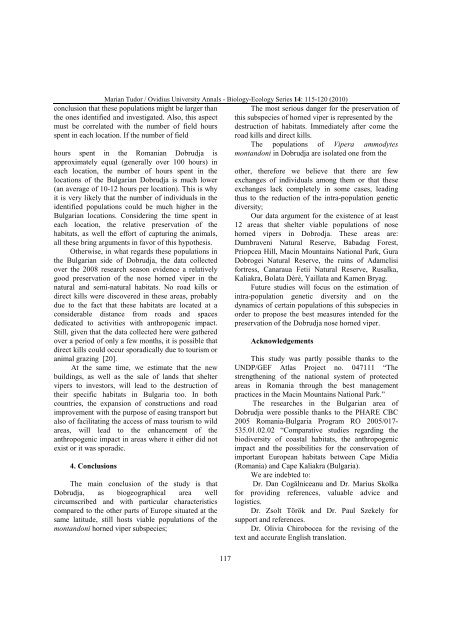VOLUM OMAGIAL - Facultatea de Ştiinţe ale Naturii şi Ştiinţe Agricole
VOLUM OMAGIAL - Facultatea de Ştiinţe ale Naturii şi Ştiinţe Agricole
VOLUM OMAGIAL - Facultatea de Ştiinţe ale Naturii şi Ştiinţe Agricole
You also want an ePaper? Increase the reach of your titles
YUMPU automatically turns print PDFs into web optimized ePapers that Google loves.
Marian Tudor / Ovidius University Annals - Biology-Ecology Series 14: 115-120 (2010)<br />
conclusion that these populations might be larger than<br />
the ones i<strong>de</strong>ntified and investigated. Also, this aspect<br />
must be correlated with the number of field hours<br />
spent in each location. If the number of field<br />
hours spent in the Romanian Dobrudja is<br />
approximately equal (generally over 100 hours) in<br />
each location, the number of hours spent in the<br />
locations of the Bulgarian Dobrudja is much lower<br />
(an average of 10-12 hours per location). This is why<br />
it is very likely that the number of individuals in the<br />
i<strong>de</strong>ntified populations could be much higher in the<br />
Bulgarian locations. Consi<strong>de</strong>ring the time spent in<br />
each location, the relative preservation of the<br />
habitats, as well the effort of capturing the animals,<br />
all these bring arguments in favor of this hypothesis.<br />
Otherwise, in what regards these populations in<br />
the Bulgarian si<strong>de</strong> of Dobrudja, the data collected<br />
over the 2008 research season evi<strong>de</strong>nce a relatively<br />
good preservation of the nose horned viper in the<br />
natural and semi-natural habitats. No road kills or<br />
direct kills were discovered in these areas, probably<br />
due to the fact that these habitats are located at a<br />
consi<strong>de</strong>rable distance from roads and spaces<br />
<strong>de</strong>dicated to activities with anthropogenic impact.<br />
Still, given that the data collected here were gathered<br />
over a period of only a few months, it is possible that<br />
direct kills could occur sporadically due to tourism or<br />
animal grazing [20].<br />
At the same time, we estimate that the new<br />
buildings, as well as the s<strong>ale</strong> of lands that shelter<br />
vipers to investors, will lead to the <strong>de</strong>struction of<br />
their specific habitats in Bulgaria too. In both<br />
countries, the expansion of constructions and road<br />
improvement with the purpose of easing transport but<br />
also of facilitating the access of mass tourism to wild<br />
areas, will lead to the enhancement of the<br />
anthropogenic impact in areas where it either did not<br />
exist or it was sporadic.<br />
4. Conclusions<br />
The main conclusion of the study is that<br />
Dobrudja, as biogeographical area well<br />
circumscribed and with particular characteristics<br />
compared to the other parts of Europe situated at the<br />
same latitu<strong>de</strong>, still hosts viable populations of the<br />
montandoni horned viper subspecies;<br />
117<br />
The most serious danger for the preservation of<br />
this subspecies of horned viper is represented by the<br />
<strong>de</strong>struction of habitats. Immediately after come the<br />
road kills and direct kills.<br />
The populations of Vipera ammodytes<br />
montandoni in Dobrudja are isolated one from the<br />
other, therefore we believe that there are few<br />
exchanges of individuals among them or that these<br />
exchanges lack completely in some cases, leading<br />
thus to the reduction of the intra-population genetic<br />
diversity;<br />
Our data argument for the existence of at least<br />
12 areas that shelter viable populations of nose<br />
horned vipers in Dobrodja. These areas are:<br />
Dumbraveni Natural Reserve, Babadag Forest,<br />
Priopcea Hill, Macin Mountains National Park, Gura<br />
Dobrogei Natural Reserve, the ruins of Adamclisi<br />
fortress, Canaraua Fetii Natural Reserve, Rusalka,<br />
Kaliakra, Bolata Dèrè, Yaillata and Kamen Bryag.<br />
Future studies will focus on the estimation of<br />
intra-population genetic diversity and on the<br />
dynamics of certain populations of this subspecies in<br />
or<strong>de</strong>r to propose the best measures inten<strong>de</strong>d for the<br />
preservation of the Dobrudja nose horned viper.<br />
Acknowledgements<br />
This study was partly possible thanks to the<br />
UNDP/GEF Atlas Project no. 047111 “The<br />
strengthening of the national system of protected<br />
areas in Romania through the best management<br />
practices in the Macin Mountains National Park.”<br />
The researches in the Bulgarian area of<br />
Dobrudja were possible thanks to the PHARE CBC<br />
2005 Romania-Bulgaria Program RO 2005/017-<br />
535.01.02.02 “Comparative studies regarding the<br />
biodiversity of coastal habitats, the anthropogenic<br />
impact and the possibilities for the conservation of<br />
important European habitats between Cape Midia<br />
(Romania) and Cape Kaliakra (Bulgaria).<br />
We are in<strong>de</strong>bted to:<br />
Dr. Dan Cogălniceanu and Dr. Marius Skolka<br />
for providing references, valuable advice and<br />
logistics.<br />
Dr. Zsolt Török and Dr. Paul Szekely for<br />
support and references.<br />
Dr. Olivia Chirobocea for the revising of the<br />
text and accurate English translation.





